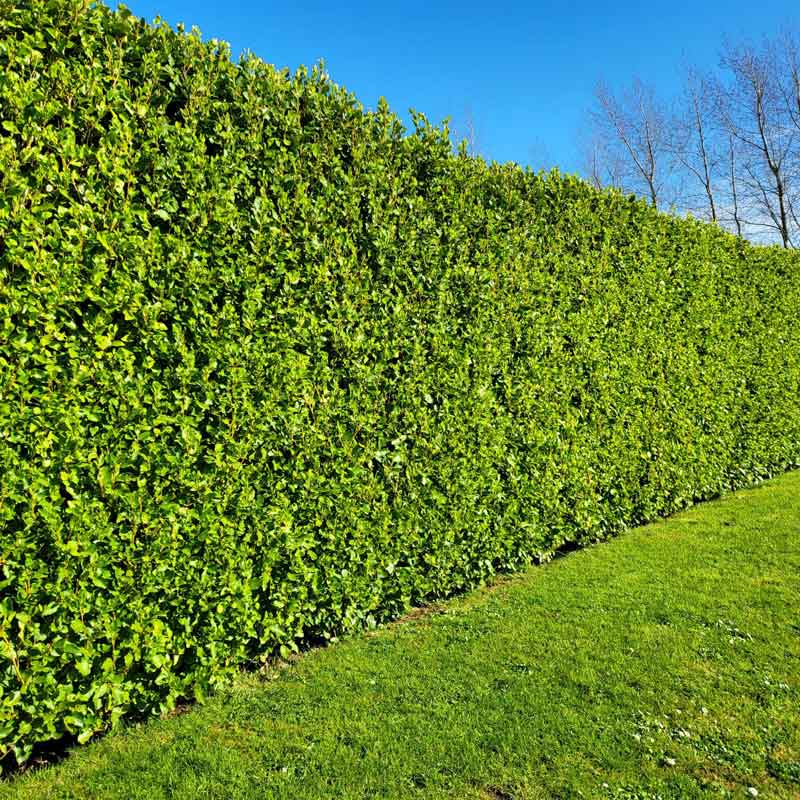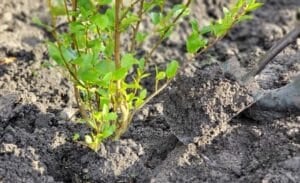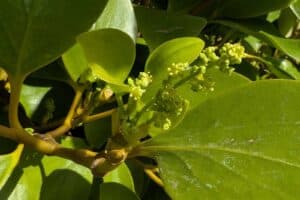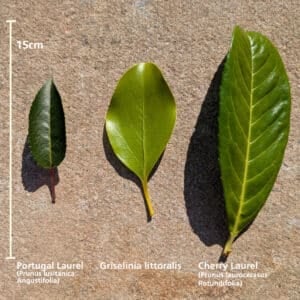Everything You Need to Know About Griselinia Littoralis Hedges

Griselinia littoralis is a shrub that is good for hedging in the UK and other parts of the world. Despite being less common than Laurel or Leylandii, its popularity is rapidly increasing due to its appealing apple-green leaves, reliable growth, and unique character.
Top facts about Griselinia littoralis:
- Griselinia has “Granny Smith apple-green” leaves
- Its common name is New Zealand Privet
- Griselinia is evergreen, so they keep their leaves all year round
- In the wild they grow up to 6 metres (20 feet high) but can easily be trimmed to stay smaller when used for hedging
- They are good habitat for wildlife with small, white flowers and blue-black berries
- Griselinia hedges are fast-growing and can grow between 50-60cm per year
- They are one of the best options for coastal gardens
- They are also popular as stand-alone ornamental shrubs or small evergreen trees
Griselinia littoralis hedges are easy to grow and low-maintenance, thriving in most soils except those prone to prolonged winter waterlogging. We have a very heavy clay soil in one area of our nursery, and even there, our Griselinia littoralis hedge is flourishing.
Griselinia will grow well in most areas of the UK. They will tolerate temperatures down to around -130C and grow in full sun or partial shade. If you have a heavily shaded area, you should consider Laurel or Portugal Laurel instead.
A Griselinia littoralis hedge is well-adapted for coastal areas because their glossy leaves can tolerate windy salt spray from the sea better than most other evergreen hedging plants. Because of this salt tolerance, Griselinia littoralis are also good for planting near roads that are gritted in the winter.
Griselinia is an excellent option if you want a hedge for privacy but you do not want conifers. Its mass of small leaves creates a solid screen, effectively blocking unwanted views and filtering air pollution from nearby roads.
How many Griselinia hedging plants do I need to form a hedge?
Measure the distance where your Griselinia littoralis hedge is going to be and divide the distance by your preferred spacing. We generally recommend spacing to be somewhere between 60cm and 100 cm apart (2-3 feet). This is measured from the centre of one plant to the centre of the next plant in the row. If spaced 60cm apart you will get a screen more quickly than if they were further apart. For example, if the total distance was 12 metres and you want them 60cm apart, you will need twenty plants. Alternatively, just measure the distance you would like to hedge and use our Hedge Spacing Calculator to help calculate how many plants you need.
What size Griselinia hedging plants do I need?
The question to ask is: Do you want a mature instant impact hedge, or are you happy to wait a few years for smaller plants to grow into a screen? Griselinia grows up to 50 to 60cm per year if they are planted well and kept watered. This means, if you don’t mind waiting, you can start with less expensive, smaller plants about 1.2 metres (4ft) high and within two years they will have grown to around 1.8 – 2 metres (6-7 feet), which is high enough to give you privacy in most situations. But if you don’t want to wait that long, you can start immediately with 1.8 metre (6 feet) plants or our Griselinia littoralis instant hedging troughs.
These are rectangular 1-metre-long containers with Griselinia hedging plants planted in a row. They have been trimmed and given time to grow into each other to create an instant screen. Simply position these troughs next to each other in a line (one per metre), and there you have your hedge!
If you are looking for individual Griselinia hedging plants, then click here for our latest sizes, prices and availability.

What is the best time of year to plant Griselinia?
Griselinia littoralis hedging plants can be planted at any time of the year. The optimum time to plant a Griselinia hedge is during the autumn, winter or early spring, or anytime from October to March, as long as the ground is not frozen. You can plant Griselinia littoralis in the summer, as they are all pot-grown, just remember to keep them watered. Griselinia hedges planted in late autumn or winter need less watering the following spring and summer as they will have established more of a root system in the soil and will be able to pick up more water from the soil.
How do I prune or trim and maintain a Griselinia hedge?
You must keep your Griselinia hedge sufficiently watered during the first year or two. In practice, this means maintaining constantly moist, but not soaking, soil around the hedge. This becomes especially crucial during dry spells.
During the initial growth period of your newly planted Griselinia littoralis hedge, you can encourage it to bush out as it grows upwards. You achieve this by regularly trimming it lightly. This repeated trimming prompts the hedge to grow side shoots, which fill it in more quickly. Once the hedge reaches your desired size, you then trim it annually.
Early summer is the best time to trim a Griselinia hedge, but make sure there are no birds nesting in it. Trim them back to your desired size, and they will have enough time to put on some re-growth to cover up the cut leaves before winter.
Does a Griselinia littoralis hedge flower?
Griselinia littoralis produces small white flowers in early spring.

Problems with a Griselinia littoralis hedge
Griselinia is generally trouble-free and very rarely suffers from pests and diseases, especially once planted out in the garden.
Griselinia littoralis tolerates cold (down to approximately -13°C), but it grows new shoots early in the year. A hard frost can occasionally blacken these fresh, new leaves. These blackened shoots then fall off, and the plant grows new ones, so this usually isn’t a cause for concern. In fact, this frost can act as an extra pruning, prompting the hedge to produce more shoots and resulting in a bushier hedge over time
Griselinia littoralis resists Honey Fungus, a soil-borne fungus that kills the roots of many plants, according to trials conducted by the RHS (Royal Horticultural Society). If Honey Fungus (Armillaria) infects your soil, this makes Griselinia littoralis a good hedging option.
Is Griselinia poisonous?
Griselinia is generally considered non-toxic to humans, pets, and livestock.
Alternatives to a Griselinia littoralis hedge
A Cherry laurel hedge makes an excellent alternative to Griselinia littoralis. They look similar at first glance, but Cherry laurel has bigger, glossier leaves. It also is better in shady areas and is slightly faster growing. Cherry Laurel is often referred to as Laurel, Common Laurel, English Laurel or Prunus laurocerasus Rotundifolia.
A Portugal laurel hedge is another great option. These have small, dark green leaves and grow clusters of white flowers in spring, and forms a dense screen just like Griselinia and Cherry Laurel. They also have a similar growth rate to Griselinia. Portugal Laurel is often called Portuguese Laurel or Prunus lusitanica Angustifolia.

One more alternative is Green Privet. Unlike Griselinia, Cherry Laurel or Portugal laurel which are true evergreens, Privet hedges are semi-evergreen, meaning they will retain some of their leaves in winter, but if it gets really cold or they are in an exposed location, they are likely to shed all their leaves in response. It has smaller mid-green leaves. Privet is also known as Ligustrum ovalifolium.


